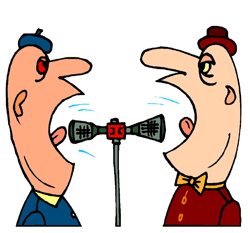As engineers we tend to form strong opinions. We base our decisions on what we hear and what we feel. And it’s important to trust these sensibilities with confidence.
Oftentimes, certain subjects will come up in which we lack technical understanding. But we don’t always need technical understanding — we need results.
Unfortunately (and fortunately) when we get those results, we equivocate that with having a correct technical understanding of everything that happened along the way.
So here’s a couple things that tend to get us audio engineers all prickly.
1) Sample Rates
What’s “the best” sample rate to record and/or mix at? Is it 44.1? 48? 88.2? 192?
We tend to divide ourselves into two camps on this one: Higher is better or lower is better. Here’s my take.
Accuracy
The crux of this argument to me is “accuracy.” First and foremost, we are asking what will give us the most accurate results when translating the continuous analog signal into the discrete digital signal.
In order to make this determination we have to first define what “accuracy” actually means.
We can take accuracy to mean the degree of similarity between the analog and digital information. If we don’t consider mechanical errors, than the higher the sample rate the higher the accuracy. We can simply capture more information at higher sample rates.
However, there are two big caveats here.
Mechanical Error
First of all, we can’t factor out mechanical errors.
They exist, and they skew accuracy. We don’t have error free conversion. And while technology is getting better every day, the fact remains: the higher the sample rate, the greater the mechanical error of the conversion process.
So while we might capture more information at 192 kHz, it’s actually less accurate than the information captured at 44.1 kHz. Oops.
Useful Accuracy
Luckily, caveat number two is that we don’t need unlimited accuracy.
We actually only need accuracy to the degree in which we can use it. It’s not very important if sound above 22 kHz is accurate — or even there at all. While it can be argued that we still sense super frequency sound content, we certainly don’t sense it in a way that makes it more important than what we can clearly hear.
When coupled with reduced storage space and better computer performance, this makes 44.1 kHz to 96kHz all perfectly fine choices, and in my opinion, superior to 176.4 kHz or 192 kHz.
Mind you, one of things we love about recording to tape is the inaccuracies it prescribes on the sound. There’s nothing to say one might not like the sound of 192 kHz—that’s subjective. And if you do—rock out. If it sounds better to you, then it is.
Easy Math
BONUS: When converting sample rates it is a complete myth that 88.2 kHz translates to 44.1 kHz more easily or accurately than 96 kHz translates to 44.1 kHz. Just because it’s vastly easier for our math-challenged minds to divide by two, to a computer, it’s no different at all.



















